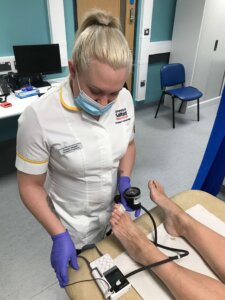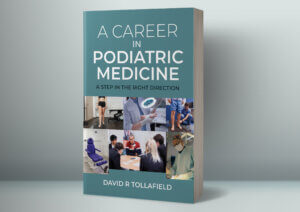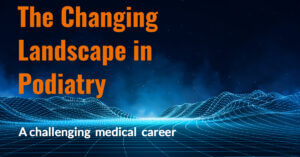Is core podiatry representative of today’s workforce?
Based on research and interviews, David Tollafield looks at updating current concepts in general podiatry practice.
Podiatrists can be poor at presenting their role. Some cannot optimise on their potential or simply have failed to grasp how to promote a profession that can do so much within healthcare. In this article, evidence is presented so that we should start to think about how to redefine our role. Podiatrists must change how they provide their first consultations with patients. Let’s go back in time…
The Full-Treatment
At college in the mid-seventies, there was a general understanding that we all were expected to provide a ‘full-treatment’ – FTx. First of all the FTx implied managing nails and hard skin, applying a cornucopia of padding, whichever fitted best to the needs of the patient and the properties of foam, felt, fleece or foam-o-felt. Appliances (not orthoses in the seventies) became the pinnacle of our prescribing and manufacturing skills. Biomechanics was not a term known to most British podiatrists. Local anaesthetics were in their infancy.
By 1983 I was teaching at Matthew Bolton School of Podiatry (sic) in Birmingham, where the FTx was still in place. By the time I reached a full-time teaching post at Northampton (Nene College), the faculty team started to change the idea of clinical practice as the new school commenced in 1985, having been influenced by what was then known as the National Record Card.
The National Record Card
The transformation from a postcard size recording sheet to A4 into a professionally printed four-sided format kick-started the change. Those older enough will recall the plethora of hieroglyphics – B/F Pl.Cov (H) Dig.Prop etc. Credit goes to the Association of Podiatry managers at the time (ACCO)[1]. The idea of a subjective, objective, assessment, plan (S.O.A.P) system influenced a change in how we approached patients in a wave of need to change the consultation.
The patient was interviewed first to identify the main concern. The idea our students would jump at looking at nails and debriding skin was not intended. The other matter of importance was that ACCO had put pressure on the Society of Chiropodists (later to become the Royal College of Podiatry) to accept the concept of Foot Care Assistants (FCA), who de facto would become clinical assistants.
The SoC determined that the advent of FCA’s would destroy podiatry, replacing the labour force with cheaper employees. But that never happened. In fact, the opposite occurred as the then Chair of ACCO [2] intended. The podiatrist slowly, and I do mean slowly, was re-indoctrinated with the idea that general foot care – meaning nails would be performed by the FCA. Today we have some comparison with another group – the Foot Health Practitioner. The FHP provides nail and skin care – here is Judith Watson,
“Podiatrists are more than nail cutters and hard skin removers because that’s what I am (as a former FHP). I’m (was) a nail cutter. I’m (was) a hard skin remover. Judith Watson – qualified podiatrist.

The need for general practice to review its own branding is essential if we ever hope to fill the gap created by a failing primary medical delivery system.
Past evidence
Dr Lisa Farndon (2006)[3] wrote up her survey on podiatric activities when the NHS sector, in particular, was still perceiving a higher proportion of nail and debridement skills. This corns, callus and nail care diet formed the basis for essential or CORE practice. To this list were added foot health advice and footwear. Fast forward 13 years and it is possible to believe that some matters have not changed while others have embraced a new technical medium. The NHS has reduced the delivery of the ideals of core podiatry to ‘high risk’ while the independent (private) sector sees MusculoSKeletal practice as an integral part of activity embracing traditional forms of podiatry.
A project that highlighted changes
In 2020, the Landscape Project [4] commenced in earnest to collect a sample of views from some 70 podiatrists about their career journeys. This included students and educationalists from 9 of the 13 podiatry-based universities. The aim was to produce a guide as no book currently had sufficient detail on podiatry as a career. Websites are misleading or, worse, fail to convince readers of the value behind podiatric medical delivery. Whitton et al (2021)[5] pointed out that many enquiring about podiatry took to websites from the USA.
Changes within Universities training students

Student Salford University Podiatry – with permission
Combining the views of current and past students, educationalists and those who have climbed the tall ladder in career advancement, the end result has provided a different landscape emerging and a pathway to future enrolment principles. Look at any school curriculum covering the podiatry course – the overall scheme exists for anatomy, sciences, physiology, medicine and surgery, but as Dr Simon Otter pointed out in personal correspondence when editing our new career book, planned for 2023, there are other inclusions in some courses offering a deeper understanding behind clinical practice. Without mentioning names, the topics are wide-ranging and expect students to be more investigative;
“Developing Resilience of Self and Others for Professional Practice, Finding Your Academic Voice, Mechanics of Normal and Pathological Gait, Health Coaching Conversations, Developing a Spirit of Inquiry, Diagnostic Investigations for Podiatric Practice, Active Citizenship, Understanding and Appraising the Evidence for Practice, Influencing Innovation and Change, Pain: Theory and Management for Podiatrists, Business for Podiatrists.” S. Otter July 2022
It was clear from other interviews, that core practice was clearly less dominant at the point of education. Students in current education reflected a clear message from universities.
Using communication skills
“You build on communication skills, which I think is an invaluable skill in podiatry. I think when people think of podiatry, they just think of nails, whereas there’s many more areas that make this only contribute to a small amount of the role of a podiatrist.” Ellen McGeough March 2021
Incorporating medicine
“Podiatry is multifaceted (has many different graduate routes to take). There’s a slice of medicine, it could be dermatology, or musculoskeletal, wound care, and the high-risk foot. Feet are a real window to your health.” Emily Reaney February 2021
When Whitton et al (2021) published their review of podiatry recruitment, specific subjects excited students entering into the healthcare field with a strong relationship with sports medicine and forensics, biomechanics upon which musculoskeletal services had developed remains as important in the independent sector as in the NHS where this had become part of MDTs and triage. The emergence of advanced clinical practitioners has further taken our professionals into the medical model – at last!
Interviews that touched on the image and emphasis on podiatry almost entirely pivoted on mechanics impinging on wound care and MSK. One of the abiding problems with promotion is the need for clarity. You cannot make a case for a service that offers mixed messages.
“Everything we do has a degree of mechanics – even the diabetic foot. The diabetic foot has manifestations mechanically because of the disease process as does rheumatoid, as does any foot deformity that you deal with and is based around the musculoskeletal system. Podiatric sports medicine is about knowing the mechanics of the different sports.” Trevor Prior The Footballer’s Podiatrist FRCPodS
Retrograde effect of chiropody
For most, the co-use of the term chiropody is an anathema to the principles of clear communication. Furthermore, there is no degree in chiropody. Temptations that drift into focusing on corns, callus and nails may be accidental; may be thought of as being correct to some, or it could be that others do not desire to move out of their comfort zone, which today is more akin to foot health practitioners. When FHP trained Judith completed her podiatry degree she was absolutely clear about what she thought of her limitations.
“I was so frustrated as an FHP because there were so many things I didn’t know and I wanted to know and so many times I’d have to refer people on to somebody else, to a podiatrist, and I thought, oh, I wish I could do that. We can only deal with low risk. Just maybe prevention, so it doesn’t go into immediate risk. When people come in and say, I’ve got a sore ankle. I want to know what that is. I want to be able to help. I want to be able to fix you. If I’m seeing somebody with maybe cellulitis, I panic. I go, please go and see your GP. I always felt I don’t know enough. So there’s definitely… They’re absolutely not the same. Judith Watson
Whitton found forensic podiatry and surgery had a magnetic attraction but of course, in these cases, both are not attainable for all podiatrists for various reasons. Forensics bolts on to existing skills, and although being carried out by some, the opportunity is still rare.
“Forensic stuff is too far outside what podiatrists are initially trained to do. Yes, there are things we do that we expect, but this is forensics. Everybody was happy to pass that over to the Chartered Society of Forensic Sciences to manage the registration scheme and recognise if there was a problem, and the forensic regulator to recognise if there was a problem and deal with that accordingly. Most people don’t do that amount of casework.” Professor Wesley Vernon PhD
Surgery is a defined specialty. It comprises a journey best suited to the younger person commencing their career journey.
To get as far as a surgical training post means that you have to have a passion for the subject. The standard of our trainees has accelerated beyond all imagination, and the breadth and depth of knowledge and also the breadth and depth of skills that are required. Professor Tim Kilmartin PhD, FRCPodS.
Is Core Podiatry the Same?
The advent of new skin surgery courses – implying biopsy and incision techniques for small lesions is important and will, in time, join up with the earlier models of nail surgery and local anaesthetic. The big question today must be, is core podiatry the same, reflecting on the margins of pedicure? I would argue not and suggests we have it all wrong.
Making conceptual changes
It is important to convert the corns, callus and nails topics to ‘screening’ and bundle these subjects with these newer roles being taught. Podiatry should be considered a medical service that needs to be established to support UK Healthcare. We should start with screening, MSK and high-risk evaluation.
It is easy to take a swipe at University courses. Are they doing enough? What are they teaching these days? The landscape project unlocked some of these concerns, revealing that there was a desire to expand and promote in every case, but there are caveats. Independent prescribing is the best example where lecturers speak of hope to implement this essential area of practice but find that courses cannot deliver sufficient mentorship as this must be done in the field.
Do you cut nails and deal with corns?
The politically correct answer is that we deal with all skin manifestations as it is part of the human body and a barometer of health. Our role is to identify the level of damage at the epidermo-dermal junction. To achieve this, we must reduce callus to identify pathology. We must determine that no wound has been allowed to develop a sinus, necrotic change or hide scar tissue. We identify hidden infections, bacterial and viral.
When it comes to the nail, we are required to establish normal growth potential, consider infection, include mycoses and ensure the nail bed has no abnormality – bone (exostosis, osteochondroma), melanoma, squamous cell carcinoma or ulceration. Circulation and neuropathy are vital clues to disease and determine foot health.

The podiatrist examines the nerve response with a monofilament
The important core part of the consultation – screening
As podiatrists with a degree in podiatric medicine, we must establish general health and health associated with limb deterioration. We consider patient well-being (mental), social as well as physical. Here is a list of objective screening concerns.
- Smoking
- Alcohol levels
- Weight and nutrition
- Cardiac output including ABPI, pulse, rate, rhythm
- Renal function
- Endocrine (pancreas)
- Sensory and motor integrity
Upskill
Here is a strong and direct criticism. While not intended to be offensive, it strikes at the problem. “I trained to be a foot specialist not deal with social issues!” There is a simple remedy; if you feel this is the case, then train to be an FHP; we need them and most are good and offer a great service. A podiatrist is a specialist whose foot does not work without the rest of the body. Dependent on nutrition and mental and psychological stability, we cannot expect to help patients with a narrow view of how they function as a whole.
Taking a good patient history can provide knowledge about patients, and their personal history and family life are just as important as hobbies, sports and occupations. On average, we spend twice the time a family GP spends on a patient.
MSK Screening
The musculoskeletal side will involve gait, foot pressure assessment, alignment and movement. The two are not mutually exclusive. As for what we do, there must be simple principles associated with four objectives –
- Alignment control where deformity exists
- Tissue preservation and integrity
- Pain assessment and management to reduce discomfort
- Optimise restoration of movement for safety, efficiency and independence
The convenient mnemonic is A.I.D = M [7]. Deal with these three elements and ideal movement will be restored for all. The professional bodies have all engaged in promoting new skills and courses. As a critic, I have pointed out in the past and will again, that it is for the membership to make a change, not the professional body. The latter remains a vehicle to support and drive the scope, desires, hopes, and investment in the delivery of modern podiatry.
Making the change
For those who struggle to make the change, here are some thoughts and suggested aims:
- Engage with FHPs positively – embrace screening and management planning
- Consider combining with practices to afford a larger group offering mixed skills (compare dental and GP practices)
- Ensure your upskilling is commensurate with the aims of your practice
- Employ podiatrists to form a larger business to cope with numbers across a broad diary
- Carefully brand your services and consider promoting your menu with a little more panache.
- Optimise your media resources, leaflets & websites.
There can be no doubt that podiatry is different to chiropody and that the future lies with a better integrated professional. We are as much about screening as planning better foot health, utilising systems of care which include the scalpel and nippers, but considered differently than the teachings of the past.

A new book covering the modern image of podiatric medicine will be available in 2023 from Amazon Books. Published by Busypencilcase Communications, it will provide the widest view of the range of care that podiatry can offer, supported by some of the top podiatrists, universities and researchers in the UK
![]()
[1] ACCO Association of Chief Chiropody Officers
[2] Marcel Pooke was Chair of ACCO and Area Chief Chiropodist for Northamptonshire before regional re-organisation
[3] Farndon, L., W. Vernon, and A. Parry. “What is the evidence for the continuation of core podiatry services in the NHS? A review of foot surveys.” British Journal of Podiatry 9.3 (2006): 89.
[4] The Landscape Project was established by Busypencilcase Communications and independent publisher owned by podiatrist David Tollafield as a career promotion project.
[5] Whitham, D., Whitham, S., Trowell, M. et al. Podiatry as a career in the UK – what attracts Generation Z? A qualitative exploration with university and college students. J Foot Ankle Res 14, 33 (2021). https://doi.org/10.1186/s13047-021-00470-y
[7] AID=M was cited in Selling Foot Health as Podiatry (2020);175. BusypencilCase Communications (Amazon books)
David Tollafield is the author-editor of ConsultingFootPain, published independently through BPCC. The quotations are taken from interviews and some of the articles have been produced on this website. For further career journeys, you can go to What Career to Choose After School?
Sign-up for here my regular FREE newsfeed
Thanks for reading ‘Core Podiatry has Changed’ by David R Tollafield
Read his latest books – ‘Podiatrist on a Mission’ and ‘Foot Health Myths, Facts & Fables’ available from Amazon in paperback and e-books and published 2021. You can also sign-up on the landing page of Consultingfootpain to receive a free copy of Foot Health and receive regular updates

Busypencilcase Reflective Communications Est. 2015



Enjoyed reading this article on our profession including its history and emphasis on practice development.
I would have like to see more endocrine conditions listed next to the example of pancreas that is given, e.g., thyroid.
Also, I found it interesting you note ‘medical model’ and would discuss and debate that further in itself. Very interesting, to share it on my Facebook page for others to read and comment.
Thank you Dawn for your comments. Please do share and ask friends to post comments if they wish. There are many endocrine organs we need to be aware of, and indeed thyroid is one, and the parathyroid is another. The adrenals are vital to the control of blood pressure and podiatrists should be competent in spotting hypertensive patients and marrying some blood disorders. The narrative remains core podiatry and expanding it to a specific medical condition does less well as far as journalism is concerned. Consultingfootpain is always delighted to receive articles on health and foot conditions. I seek to create debate, new thoughts and change in practice to improve podiatric delivery. David